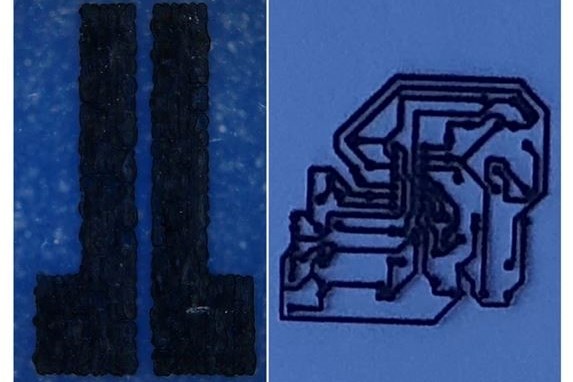Researchers develop scalable graphene production method for industrialization opportunities
Semi-automated, in-line process, which addresses high startup and labor costs, is considered essential in scaling for commercial applications, showing potential for fiber reinforcement and printed sensors.

Optical image inkjet-printed transistor contacts (left) and interconnect (right). The scale bar is 100 micrometers (left) and 1 centimeter (right). Photo Credit, all images: “Cyclic production of biocompatible few-layer graphene ink with in-line shear-mixing for inkjet-printed electrodes and Li-ion energy storage”
Researchers at the SFI Advanced Materials and BioEngineering Research (AMBER, Dublin, Ireland) and Trinity’s School of Physics (Dublin), alongside colleagues at the Cambridge Graphene Centre (U.K.), University of Cambridge, Newcastle University and the University of Stavanger (Norway) have announced the development of a next-generation, low-cost scalable production method for graphene in the Nature Journal 2D Materials and Applications. Research suggestions that the process could substantially reduce graphene production costs to ~£20 (~$27) per liter once scaled, and produce multi-tonne quantities if successfully commercialized, far exceeding the current global graphene supply (~one kilotonne). This could potentially aid in accererating the adoption of graphene to industry and encourage graphene manufacturers that have previously been hampered by high capital equipment and labor costs.
Graphene and other atomically thin “2D materials” are expected to find major commercial applications in the coming years as a result of distinctive electrical, optical, mechanical, chemical and thermal properties. Graphene can be used as a barrier material for anti-corrosion, an additive for mechanical reinforcement in polymers or as a conductive material in sensors. According to researchers, these applications will require high-quality, defect-free graphene supplied in quantities exceeding current supplies at lower costs.
The research team’s approach is based on the graphite exfoliation process — a bulk method for producing graphene from graphite. They have found a novel, low-turbulence, semi-automated process through engineering the fluid dynamics to exfoliate graphene flakes from graphite with minimal defects. The method not only produces high-quality graphene ‘flakes’ suitable for industrial commercialization — and ideal for applications requiring high conductivity — but is a low-cost, in-line and enclosed process that also recycles unused graphite, ensuring high efficiency.

Schematic of the novel in-line process. Graphite, deionized water and SDC stabilization agent are added to the reservoir. The shear rotor head pushes the material around the system while generating shear force, enabling the exfoliation of graphite into graphene.
Building on this approach, the team created high-quality graphene inks and used household ink-jet printers to make conductive interconnects and lithium-ion battery anode composites that could potentially connect a battery to a textile sensor which could then be used to measure vital signs in the wearable health industry, amongst other applications. Given the applications in wearable electronics, textile electronics, composites and printed interconnects that could involve human contact with high concentrations of graphene, the team worked with colleagues at the University of Stavanger to determine the biocompatibility of the graphene inks. Repeated measurements showed no acute toxicity found when using the highest concentration of graphene in 48h cell culture treatments.
“We have demonstrated energy storage composites and printed electronic components in our work, however, there are many more applications that could be achieved with the graphene inks, such as [fiber]-reinforced composites or printed sensors,” says the research’s lead author, Dr. Tian Carey, who suggests this is just the start. “Also, graphene is just one example of a conductive 2D material; there are hundreds other lesser-known 2D materials which have different but complementary electronic behavior that we can apply this process to and create a suite of inks with different but complementary properties.”
“About ten years ago, I pioneered a simple method of making graphene from graphite through exfoliation in a household kitchen blender that has since been scaled and commercialized,” adds Prof. Jonathon Coleman, commenting on his team and collaborators’ success. “In this work, we have adapted the method further for industrial application and shown we can produce high-quality graphene at low cost in a highly efficient manner that is easily scalable.”
The study was funded by Science Foundation Ireland, a Marie Skłodowska-Curie Action Individual fellowship “MOVE,” and supported by the Engineering and Physical Sciences Research Council (EPSRC), in the U.K.
Read the complete research article here.
Read Next
“Structured air” TPS safeguards composite structures
Powered by an 85% air/15% pure polyimide aerogel, Blueshift’s novel material system protects structures during transient thermal events from -200°C to beyond 2400°C for rockets, battery boxes and more.
Read MoreAll-recycled, needle-punched nonwoven CFRP slashes carbon footprint of Formula 2 seat
Dallara and Tenowo collaborate to produce a race-ready Formula 2 seat using recycled carbon fiber, reducing CO2 emissions by 97.5% compared to virgin materials.
Read MorePlant tour: Daher Shap’in TechCenter and composites production plant, Saint-Aignan-de-Grandlieu, France
Co-located R&D and production advance OOA thermosets, thermoplastics, welding, recycling and digital technologies for faster processing and certification of lighter, more sustainable composites.
Read More














.jpg;maxWidth=300;quality=90)







